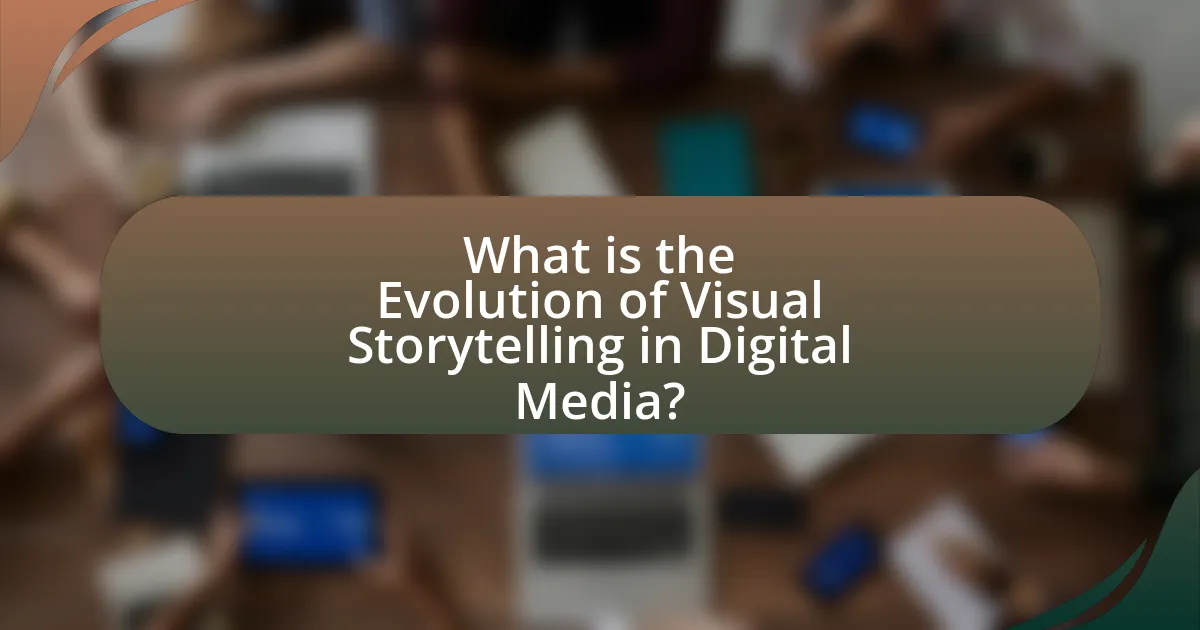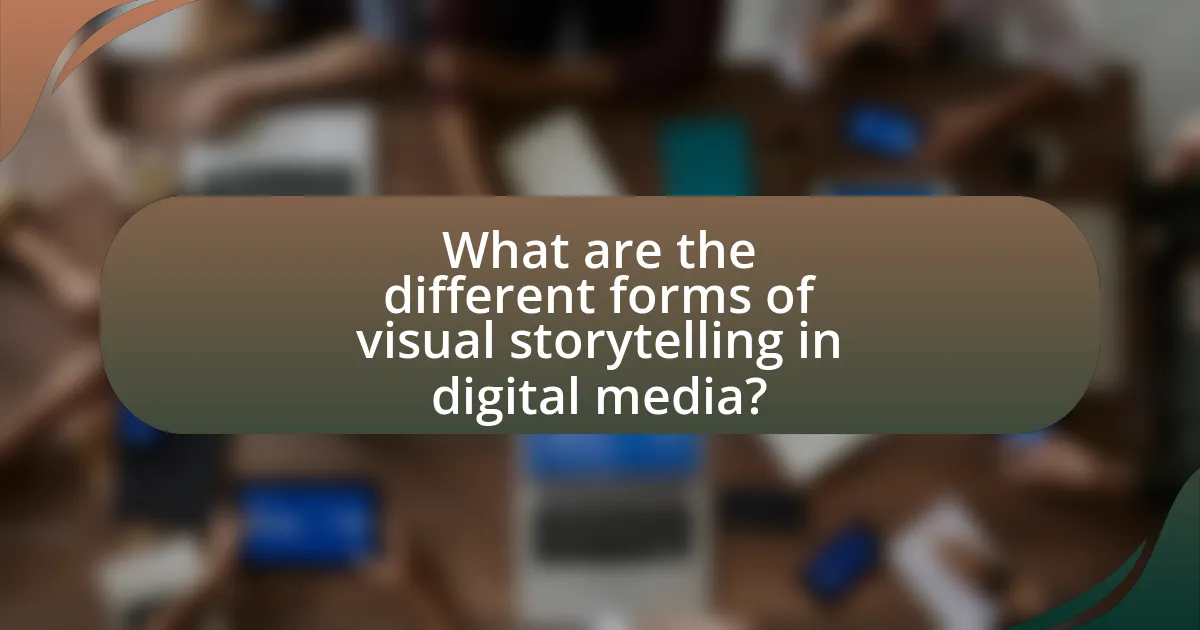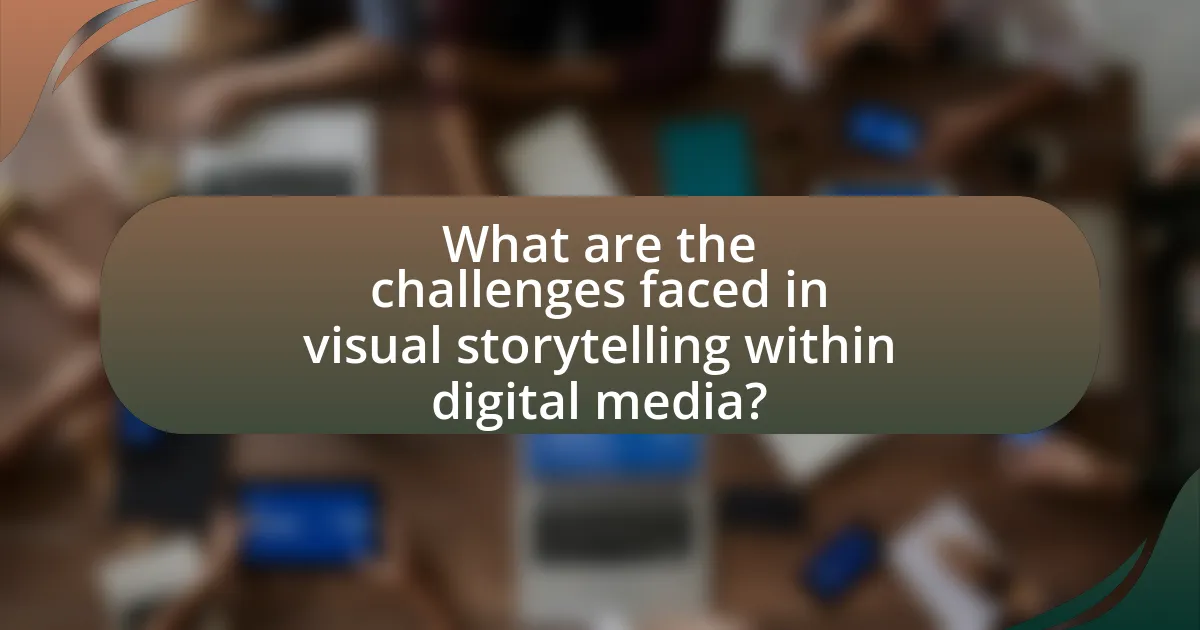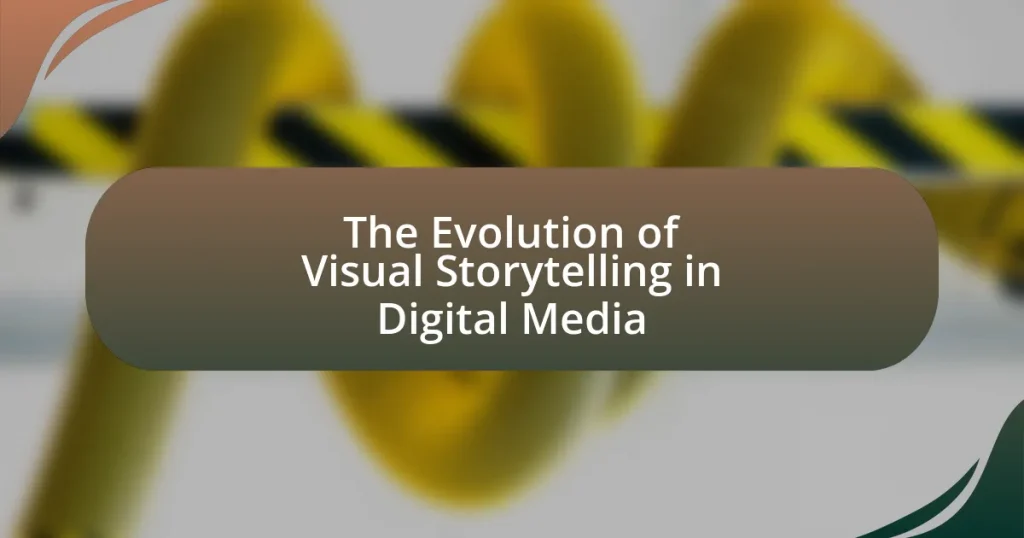The article examines the evolution of visual storytelling in digital media, highlighting its transformation from traditional static images to dynamic, interactive experiences. It discusses key milestones, including the impact of digital technology, social media, and advancements like augmented and virtual reality on narrative engagement. The article also explores the significance of visual storytelling in enhancing communication, audience retention, and emotional connection, while addressing challenges faced by creators and emerging trends that shape the future of storytelling. Techniques, best practices, and strategies for effective visual storytelling are also outlined, emphasizing the importance of clarity, emotional engagement, and interactivity in digital narratives.

What is the Evolution of Visual Storytelling in Digital Media?
The evolution of visual storytelling in digital media has transformed significantly from static images to dynamic, interactive experiences. Initially, visual storytelling relied on traditional mediums such as paintings and photographs, which conveyed narratives through fixed imagery. With the advent of digital technology in the late 20th century, storytelling began to incorporate animations and video, allowing for more engaging and immersive experiences.
The rise of the internet in the 1990s further accelerated this evolution, enabling the sharing of multimedia content across platforms. Social media platforms, emerging in the early 2000s, revolutionized visual storytelling by allowing users to create and share their narratives through images, videos, and live broadcasts. According to a 2021 report by Statista, over 3.6 billion people used social media worldwide, highlighting the vast audience for visual storytelling.
In recent years, advancements in technology, such as augmented reality (AR) and virtual reality (VR), have introduced new dimensions to visual storytelling, enabling users to experience narratives in immersive environments. A study published in the Journal of Visual Communication and Image Representation in 2020 found that AR applications significantly enhance user engagement and emotional connection to stories.
Overall, the evolution of visual storytelling in digital media reflects a shift towards more interactive, participatory, and immersive experiences, driven by technological advancements and changing audience expectations.
How has visual storytelling changed with the advent of digital media?
Visual storytelling has transformed significantly with the advent of digital media, primarily through enhanced accessibility, interactivity, and the integration of multimedia elements. Digital platforms allow creators to reach wider audiences instantly, enabling the sharing of stories across various formats such as video, animation, and interactive graphics. For instance, social media platforms like Instagram and TikTok have popularized short-form visual content, changing how narratives are constructed and consumed. Additionally, tools like augmented reality (AR) and virtual reality (VR) have introduced immersive experiences, allowing audiences to engage with stories in a more participatory manner. This shift is supported by statistics indicating that video content is projected to account for 82% of all consumer internet traffic by 2022, highlighting the growing importance of visual storytelling in digital communication.
What are the key milestones in the evolution of visual storytelling?
The key milestones in the evolution of visual storytelling include the development of cave paintings around 30,000 years ago, which marked the earliest form of visual narrative. The invention of the printing press in the 15th century revolutionized storytelling by making illustrated books widely accessible. The emergence of photography in the 19th century introduced a new medium for capturing and conveying stories visually. The 20th century saw the rise of film, which combined visual and auditory elements to create immersive narratives. The advent of digital technology in the late 20th century and early 21st century transformed visual storytelling through the internet, social media, and interactive media, allowing for real-time engagement and user-generated content. Each of these milestones significantly shaped how stories are told and consumed, reflecting advancements in technology and changes in audience interaction.
How have technological advancements influenced visual storytelling?
Technological advancements have significantly influenced visual storytelling by enhancing the tools and platforms available for creators, allowing for more immersive and engaging narratives. Innovations such as high-definition cameras, computer-generated imagery (CGI), and virtual reality (VR) have transformed how stories are told, enabling filmmakers and artists to create visually stunning experiences that were previously impossible. For instance, the introduction of CGI in films like “Jurassic Park” in 1993 revolutionized the industry by allowing for realistic depictions of dinosaurs, which captivated audiences and set new standards for visual effects. Additionally, the rise of digital platforms and social media has democratized storytelling, enabling a wider range of voices and styles to emerge, as seen in the popularity of web series and short films on platforms like YouTube and TikTok. These advancements not only enhance the aesthetic quality of visual storytelling but also expand its accessibility and reach, fundamentally changing how narratives are created and consumed.
Why is visual storytelling important in the digital age?
Visual storytelling is important in the digital age because it enhances engagement and retention of information. Studies show that visuals are processed 60,000 times faster than text, making them a powerful tool for communication. In a landscape saturated with content, effective visual narratives capture attention and convey messages more efficiently, leading to higher audience interaction and understanding. For instance, research by the Wharton School of Business indicates that people remember only 10% of information they hear, but when paired with relevant visuals, retention rates can increase to 65%. This demonstrates that visual storytelling is not just a creative choice but a strategic necessity for effective communication in the digital realm.
What role does visual storytelling play in audience engagement?
Visual storytelling significantly enhances audience engagement by creating an emotional connection and facilitating information retention. Studies indicate that visuals are processed 60,000 times faster than text, making them a powerful tool for capturing attention and conveying messages effectively. For instance, research from the Wharton School of Business found that people remember only 10% of information when presented verbally, but retention jumps to 65% when paired with relevant visuals. This demonstrates that visual storytelling not only attracts viewers but also helps them retain and recall information, thereby increasing overall engagement.
How does visual storytelling enhance communication in digital media?
Visual storytelling enhances communication in digital media by effectively conveying complex information through engaging visuals, which can increase audience retention and understanding. Research indicates that visuals are processed 60,000 times faster than text, allowing for quicker comprehension of messages. Additionally, studies show that people remember 80% of what they see and do, compared to only 20% of what they read. This demonstrates that incorporating images, videos, and infographics in digital content significantly boosts the clarity and impact of the communication, making it more memorable and accessible to diverse audiences.

What are the different forms of visual storytelling in digital media?
Different forms of visual storytelling in digital media include infographics, videos, animations, interactive graphics, and virtual reality experiences. Infographics combine text and visuals to present information clearly and engagingly, while videos utilize motion and sound to convey narratives effectively. Animations bring static images to life, allowing for creative expression and storytelling. Interactive graphics enable user engagement by allowing audiences to explore content actively, and virtual reality experiences immerse users in a 3D environment, enhancing the storytelling experience. Each form leverages technology to enhance narrative delivery and audience engagement.
How do various platforms utilize visual storytelling?
Various platforms utilize visual storytelling by integrating images, videos, and graphics to convey narratives effectively. Social media platforms like Instagram and TikTok leverage short-form videos and visually appealing images to engage users, fostering a sense of community and personal connection. Streaming services such as Netflix employ high-quality visuals and compelling cinematography to enhance storytelling, drawing viewers into immersive experiences. Additionally, websites and blogs utilize infographics and visual content to simplify complex information, making it more accessible and engaging for audiences. Research indicates that visual content is processed 60,000 times faster than text, underscoring its effectiveness in communication across these platforms.
What are the unique characteristics of visual storytelling on social media?
Visual storytelling on social media is characterized by its immediacy, interactivity, and visual-centric approach. This medium allows for rapid dissemination of narratives through images, videos, and graphics, engaging audiences quickly and effectively. The use of platforms like Instagram and TikTok emphasizes short, impactful content that captures attention within seconds, as studies show that users often decide within 3 seconds whether to engage with a post. Additionally, social media enables user interaction through comments, shares, and likes, fostering a sense of community and participation in the storytelling process. This interactive element enhances emotional connection and encourages user-generated content, further enriching the narrative landscape.
How does visual storytelling differ in video content versus static images?
Visual storytelling in video content differs from static images primarily in its ability to convey narrative through motion and sound. Video allows for dynamic storytelling, utilizing elements such as pacing, transitions, and audio to create an immersive experience that can evoke emotions and build tension over time. In contrast, static images rely on composition, color, and symbolism to communicate a message instantly, requiring viewers to interpret the story within a single frame. Research indicates that videos can increase viewer retention by up to 95% compared to 10% for text alone, highlighting the effectiveness of motion in storytelling.
What techniques are commonly used in visual storytelling?
Common techniques used in visual storytelling include the use of imagery, color theory, composition, and narrative structure. Imagery captures the audience’s attention and conveys emotions, while color theory influences mood and perception; for instance, warm colors often evoke feelings of warmth and comfort, whereas cool colors can create a sense of calm or sadness. Composition, which involves the arrangement of visual elements, guides the viewer’s eye and emphasizes key aspects of the story. Narrative structure organizes the sequence of events, helping to build tension and engagement. These techniques are foundational in creating compelling visual narratives that resonate with audiences across various digital media platforms.
How do narrative structures impact visual storytelling effectiveness?
Narrative structures significantly enhance visual storytelling effectiveness by providing a coherent framework that guides audience engagement and emotional response. A well-defined narrative structure, such as the three-act structure, helps to organize the plot, develop characters, and create tension, which are essential for maintaining viewer interest. Research indicates that stories with clear beginnings, middles, and ends are more memorable and impactful; for instance, a study published in the journal “Cognitive Science” by Paul Zak found that narratives that evoke emotional responses lead to higher levels of engagement and retention among audiences. Thus, effective narrative structures not only facilitate comprehension but also amplify the emotional resonance of visual storytelling.
What visual elements are essential for compelling storytelling?
Compelling storytelling relies on essential visual elements such as imagery, color, composition, and typography. Imagery captures attention and conveys emotions, while color sets the mood and influences perception; for instance, warm colors evoke warmth and excitement, whereas cool colors can create calmness. Composition organizes visual elements to guide the viewer’s eye and enhance narrative flow, as seen in the rule of thirds, which creates balance and interest. Typography, the style and arrangement of text, communicates tone and reinforces the story’s message, with font choices impacting readability and emotional resonance. These elements work together to create an engaging and immersive storytelling experience, as evidenced by successful campaigns in digital media that utilize these principles effectively.

What are the challenges faced in visual storytelling within digital media?
Visual storytelling in digital media faces several challenges, including information overload, audience fragmentation, and technological limitations. Information overload occurs when excessive content overwhelms viewers, making it difficult for them to engage with a single narrative. Audience fragmentation arises from diverse platforms and preferences, leading to varied viewer experiences and expectations. Technological limitations, such as varying internet speeds and device compatibility, can hinder the delivery and quality of visual content. These challenges impact the effectiveness of storytelling, as creators must navigate a complex landscape to capture and retain audience attention.
How do creators overcome the limitations of digital platforms?
Creators overcome the limitations of digital platforms by diversifying their content distribution methods and engaging directly with their audiences. By utilizing multiple platforms, such as social media, personal websites, and email newsletters, creators can reach wider audiences and mitigate the restrictions imposed by any single platform’s algorithms or policies. For instance, a study by the Pew Research Center indicates that 72% of adults use at least one social media site, highlighting the importance of multi-platform engagement for visibility. Additionally, creators often leverage analytics tools to understand audience preferences and optimize their content accordingly, ensuring that they remain relevant and connected despite platform constraints.
What are the common pitfalls in visual storytelling?
Common pitfalls in visual storytelling include lack of clarity, overcomplication, and neglecting the audience’s perspective. Lack of clarity occurs when the visual narrative fails to convey a clear message, leading to confusion. Overcomplication arises when too many elements are included, distracting from the core story. Neglecting the audience’s perspective can result in visuals that do not resonate or engage viewers, diminishing the impact of the storytelling. These pitfalls can undermine the effectiveness of visual narratives, making it essential for creators to focus on simplicity, coherence, and audience engagement.
How can creators ensure their stories resonate with diverse audiences?
Creators can ensure their stories resonate with diverse audiences by incorporating authentic representation and cultural sensitivity in their narratives. This involves understanding and reflecting the varied experiences, backgrounds, and perspectives of different communities. Research indicates that inclusive storytelling not only broadens audience engagement but also enhances relatability; for instance, a study by the Geena Davis Institute on Gender in Media found that films with diverse casts perform better at the box office, demonstrating the commercial viability of inclusive narratives. By actively seeking input from diverse voices during the creative process, creators can craft stories that genuinely reflect the richness of human experience, thereby fostering connection and empathy among a wider audience.
What future trends are emerging in visual storytelling?
Future trends in visual storytelling include the rise of immersive technologies, such as virtual reality (VR) and augmented reality (AR), which enhance audience engagement by creating interactive experiences. According to a report by PwC, the global VR and AR market is expected to reach $1.5 trillion by 2030, indicating a significant shift towards these technologies in storytelling. Additionally, the use of artificial intelligence (AI) in content creation is becoming prevalent, allowing for personalized narratives that adapt to viewer preferences. A study by Adobe found that 61% of marketers believe AI will revolutionize the way stories are told in the next five years. Furthermore, short-form video content, driven by platforms like TikTok, is shaping how stories are consumed, with 68% of marketers planning to increase their investment in short videos. These trends illustrate a transformative evolution in how visual narratives are crafted and experienced in the digital landscape.
How might advancements in technology shape the future of visual storytelling?
Advancements in technology will significantly shape the future of visual storytelling by enhancing interactivity, accessibility, and realism. Technologies such as virtual reality (VR) and augmented reality (AR) allow audiences to engage with narratives in immersive environments, creating a more personal and impactful experience. For instance, a study by the University of Southern California found that VR storytelling can increase emotional engagement by up to 30% compared to traditional media. Additionally, artificial intelligence (AI) is streamlining content creation, enabling storytellers to analyze audience preferences and tailor narratives accordingly, which can lead to more relevant and engaging stories. Furthermore, advancements in graphics and animation technology are making it possible to create hyper-realistic visuals that can captivate audiences, as seen in films like “Avatar,” which utilized groundbreaking visual effects to enhance storytelling. These technological innovations are not only transforming how stories are told but also expanding the possibilities for audience interaction and engagement.
What role will interactivity play in the evolution of visual storytelling?
Interactivity will play a crucial role in the evolution of visual storytelling by enhancing audience engagement and personalizing narratives. As digital media continues to advance, interactive elements such as user choices, branching storylines, and immersive experiences will allow viewers to influence the direction and outcome of stories. This shift is supported by the rise of platforms like Netflix, which has experimented with interactive films like “Black Mirror: Bandersnatch,” demonstrating that audiences are increasingly drawn to content that allows them to participate actively in the storytelling process. Furthermore, research indicates that interactive storytelling can lead to higher retention rates and emotional investment, as users feel a sense of agency and connection to the narrative.
What best practices should creators follow in visual storytelling?
Creators should follow the best practices of clarity, emotional engagement, and narrative structure in visual storytelling. Clarity ensures that the visuals communicate the intended message without confusion, which is supported by research indicating that clear visuals enhance audience comprehension by up to 80%. Emotional engagement involves using relatable characters and situations to connect with the audience, as studies show that emotionally charged stories are remembered 22 times more than non-emotional ones. Finally, a strong narrative structure, including a clear beginning, middle, and end, helps maintain audience interest and retention, as evidenced by storytelling frameworks like the Hero’s Journey, which has been utilized in successful films and literature for decades.
How can creators effectively measure the impact of their visual stories?
Creators can effectively measure the impact of their visual stories by utilizing analytics tools that track engagement metrics such as views, shares, comments, and conversion rates. These metrics provide quantitative data that reflects audience interaction and interest. For instance, platforms like Google Analytics and social media insights offer detailed reports on how viewers engage with visual content, allowing creators to assess which elements resonate most with their audience. Additionally, conducting surveys and gathering qualitative feedback can provide deeper insights into audience perceptions and emotional responses to the visual stories. This combination of quantitative and qualitative data enables creators to refine their storytelling techniques and enhance future content.
What strategies can enhance the effectiveness of visual storytelling in digital media?
To enhance the effectiveness of visual storytelling in digital media, utilizing a combination of compelling visuals, narrative structure, and audience engagement strategies is essential. Compelling visuals, such as high-quality images and videos, capture attention and evoke emotions, which are crucial for storytelling. A well-defined narrative structure, including a clear beginning, middle, and end, helps convey the message effectively and keeps the audience engaged. Additionally, incorporating interactive elements, such as polls or clickable content, fosters audience participation and enhances retention of the story. Research indicates that stories with strong visual elements are 65% more likely to be remembered by audiences, demonstrating the importance of these strategies in creating impactful visual narratives.
